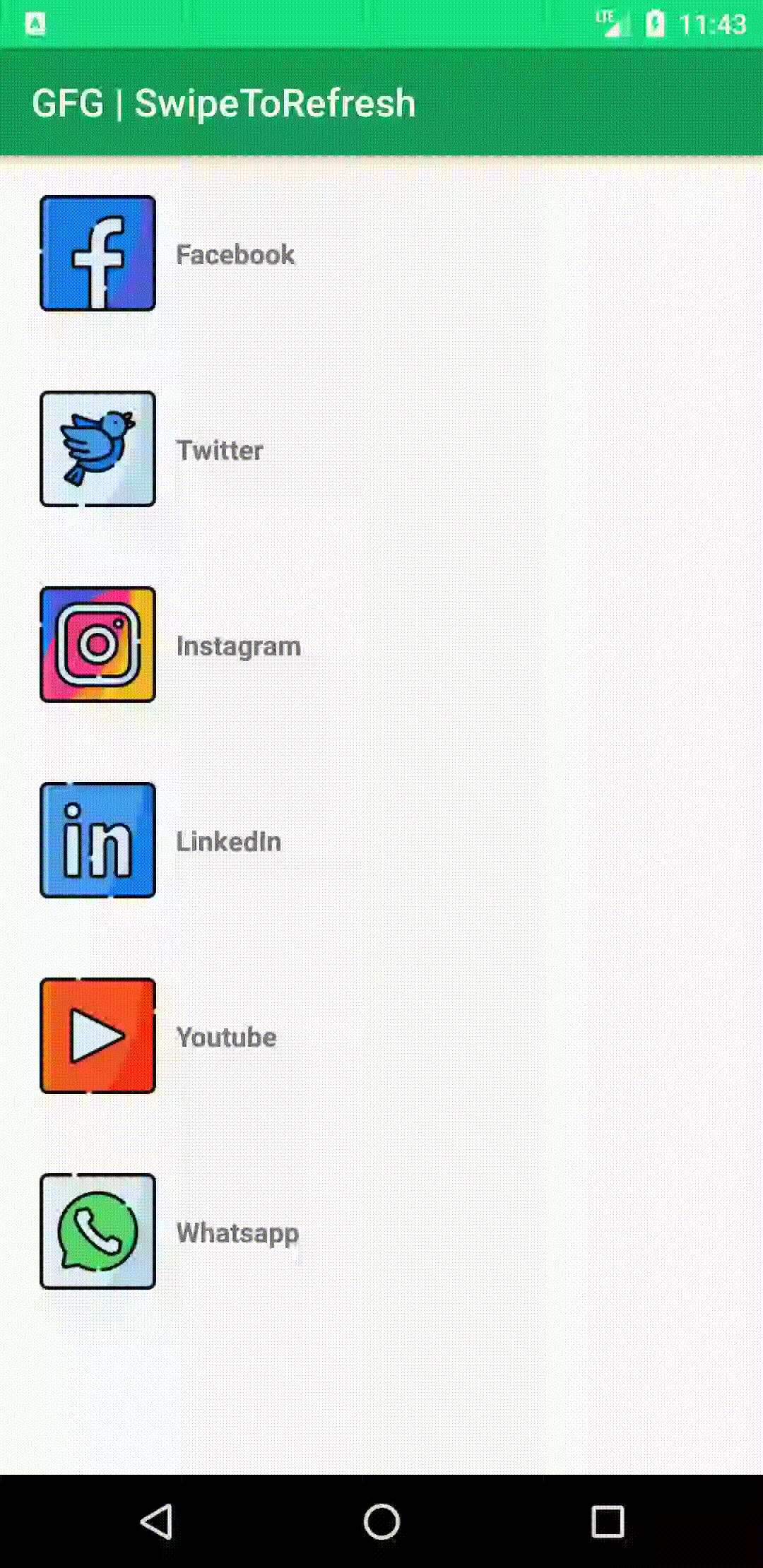Pull to Refresh with RecyclerView in Android with Example - Software Development PDF Download
Pull to Refresh with RecyclerView in Android with Example
- Last Updated: 01 Oct, 2021
Introduction to SwipeRefreshLayout Widget
The SwipeRefreshLayout widget is utilized to implement a swipe-to-refresh user interface design pattern in Android applications. Users can refresh the content of views by performing a vertical swipe gesture. This widget detects the vertical swipe, displays a progress bar, and triggers callback methods within the app. Applications like Gmail, YouTube, Facebook, and Instagram make use of this Material Design UI pattern to enable manual refreshing of content.
SwipeRefreshLayout Class and OnRefreshListener
The SwipeRefreshLayout class includes a listener known as OnRefreshListener. Classes intending to utilize this listener must implement the SwipeRefreshLayout.OnRefreshListener interface. When a vertical swipe-down gesture is detected, the onRefresh() method is triggered. It can be overridden as needed to handle the refresh behavior.
Implementation Example
In the following example, data will be stored in an ArrayList to populate a RecyclerView. Upon calling the onRefresh() method, the data in the ArrayList will be reorganized. The project will be implemented using the Java language. Below is a sample GIF illustrating the functionality:

Step by Step Implementation
Step 1: Create a New Project
To initiate a new project in Android Studio, follow these steps:
Start by creating a new project in Android Studio. Ensure that you choose Java as the programming language.
Step 2: Adding dependencies
Now, let's add dependencies for RecyclerView and SwipeRefreshLayout:
In your Android Studio project, navigate to Gradle Scripts > build.gradle(Module: app) and incorporate the following dependencies:
- implementation "androidx.recyclerview:recyclerview:1.1.0"
- implementation "androidx.swiperefreshlayout:swiperefreshlayout:1.1.0"
After adding these dependencies, remember to click on 'Sync Now'.
Step 3: Working with the activity_main.xml file
Proceed with the following tasks in your activity_main.xml file:
Add SwipeRefreshLayout and RecyclerView by inserting the provided code snippet:
Creating RecyclerView List Items
Step 4: Create a new layout file list_item.xml for the list items of RecyclerView
Within your Android project, navigate to the following path: app > res > layout. Right-click, go to New, and select Layout Resource File. Name this file as list_item. This layout file (list_item.xml) will comprise an ImageView and a TextView, essential for populating the rows of the RecyclerView.
Contents of list_item.xml File
The list_item.xml file includes a LinearLayout containing an ImageView and a TextView. The ImageView is set to display an image (ic_launcher) while the TextView shows text ("GeeksForGeeks" in this case).
<LinearLayout xmlns:android="http://schemas.android.com/apk/res/android" android:layout_width="match_parent" android:layout_height="wrap_content" android:layout_margin="10dp" android:orientation="horizontal" android:padding="10dp">
<ImageView android:id="@id/imageView" android:layout_width="120dp" android:layout_height="120dp" android:scaleType="fitXY" android:src="https://cn.edurev.in/mipmap/ic_launcher" />
<TextView android:id="@id/textView" android:layout_width="wrap_content" android:layout_height="wrap_content" android:layout_gravity="center_vertical" android:paddingStart="10dp" android:text="GeeksForGeeks" />
</LinearLayout>
Step 5: Creating Adapter class for RecyclerView
- Create a new Java class named Adapter in the specified package. This class will extend RecyclerView.Adapter with ViewHolder.
- In the Adapter class, you will override the onCreateViewHolder() method. This method inflates the list_item.xml layout and passes it to the ViewHolder.
- Next, you will implement the onBindViewHolder() method in the Adapter class. This method is responsible for setting data to the Views using the ViewHolder.
- Below is a summarized code snippet for the Adapter.java class:
Adapter.java class
- The Adapter class extends RecyclerView.Adapter and implements necessary methods.
- It contains constructors for initializing context, images, and text.
- The onCreateViewHolder() method inflates the list_item.xml layout file into a View object.
- The onBindViewHolder() method binds data to specified positions.
Code Snippet
import android.content.Context; | import android.view.LayoutInflater; | import android.view.View; | import android.view.ViewGroup; |
import android.widget.ImageView; | import android.widget.TextView; | import androidx.annotation.NonNull; | import androidx.recyclerview.widget.RecyclerView; |
import java.util.ArrayList; |
- The ViewHolder class initializes views for images and text.
- The Adapter class is responsible for managing data and binding it to the RecyclerView.
- It ensures that the correct data is displayed in the appropriate positions within the RecyclerView.
Working with MainActivity.java file
- Creating ArrayLists in MainActivity.java to store images and text data.
- Images are stored in the drawable folder, and references to SwipeRefreshLayout and RecyclerView are obtained.
- Setting the LayoutManager and Adapter for RecyclerView to display items and implementing onRefreshListener.
MainActivity.java Code Snippet
import android.os.Bundle; import androidx.appcompat.app.AppCompatActivity; import androidx.recyclerview.widget.LinearLayoutManager; import androidx.swiperefreshlayout.widget.SwipeRefreshLayout; import java.util.ArrayList; import java.util.Arrays; import java.util.Collections; import java.util.Random; public class MainActivity extends AppCompatActivity { SwipeRefreshLayout swipeRefreshLayout; RecyclerView recyclerView; // Using ArrayList to store images and text data ArrayList images = new ArrayList< />(Arrays.asList(R.drawable.facebook, R.drawable.twitter, R.drawable.instagram, R.drawable.linkedin, R.drawable.youtube, R.drawable.whatsapp)); ArrayList text = new ArrayList< />(Arrays.asList("Facebook", "Twitter", "Instagram", "LinkedIn", "Youtube", "WhatsApp")); @Override protected void onCreate(Bundle savedInstanceState) { super.onCreate(savedInstanceState); setContentView(R.layout.activity_main); swipeRefreshLayout = (SwipeRefreshLayout) findViewById(R.id.swipeRefreshLayout); recyclerView = (RecyclerView) findViewById(R.id.recyclerView); LinearLayoutManager linearLayoutManager = new LinearLayoutManager(getApplicationContext()); recyclerView.setLayoutManager(linearLayoutManager); Adapter adapter = new Adapter(MainActivity.this, images, text); recyclerView.setAdapter(adapter); swipeRefreshLayout.setOnRefreshListener(new SwipeRefreshLayout.OnRefreshListener() { @Override public void onRefresh() { swipeRefreshLayout.setRefreshing(false); RearrangeItems(); } }); } public void RearrangeItems() { Collections.shuffle(images, new Random(System.currentTimeMillis())); Collections.shuffle(text, new Random(System.currentTimeMillis())); Adapter adapter = new Adapter(MainActivity.this, images, text); recyclerView.setAdapter(adapter); } } |
Output:
- Video Player
- 00:00
- 00:13
- Use Up/Down Arrow keys to increase or decrease volume.
Please Login to comment...
- Login
- Like














